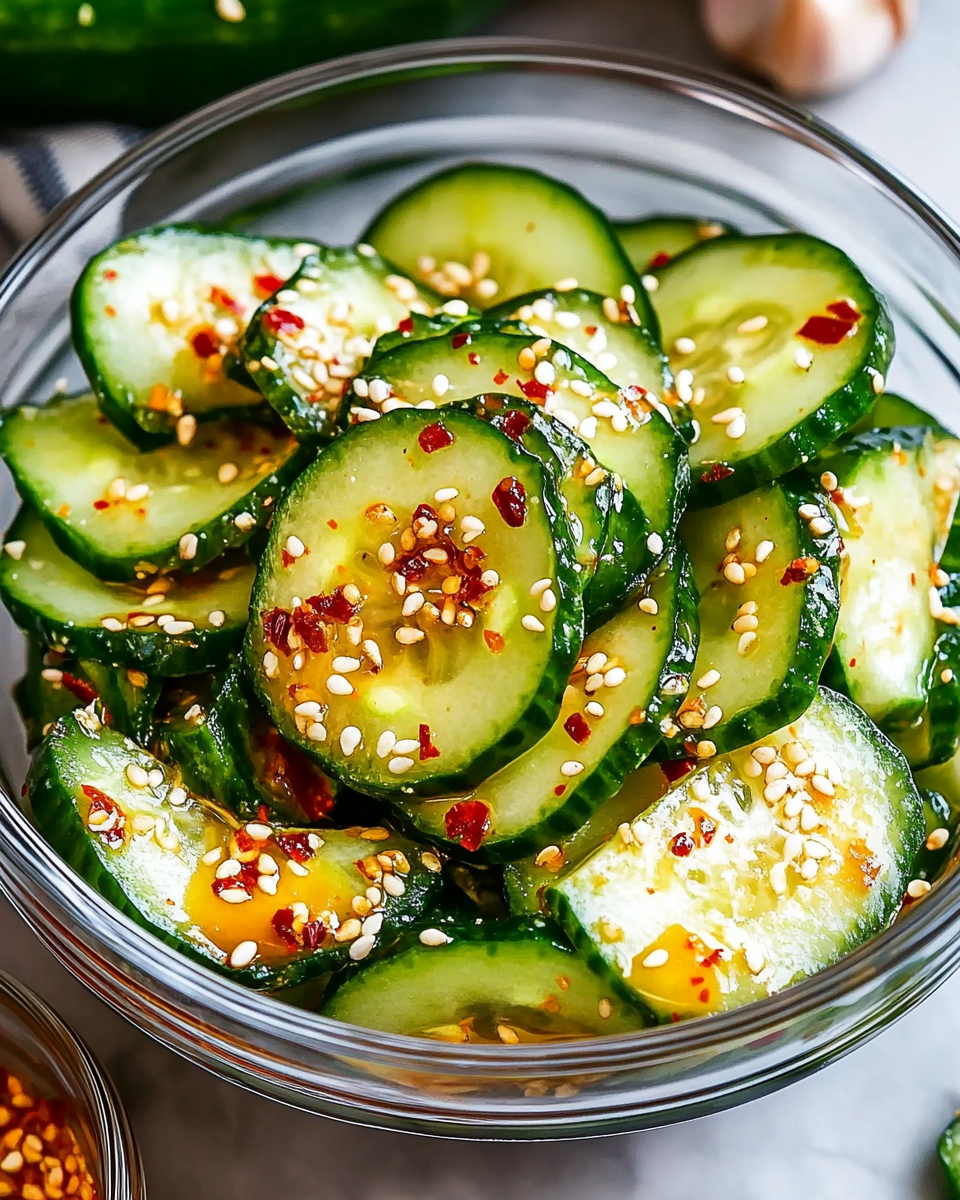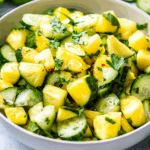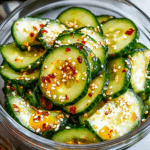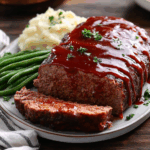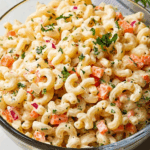A refreshing, tangy, and slightly spicy Korean side dish, Oi Muchim (Korean Cucumber Salad) is a quick and flavorful addition to any meal. Traditionally served as a banchan (side dish), this salad pairs beautifully with grilled meats or rice-based dishes. Crisp cucumber slices absorb the savory-spicy marinade, making every bite vibrant and addictive.
FULL RECIPE
Ingredients
- 2 medium Korean or Persian cucumbers (or 1 English cucumber)
- 1 tsp salt
- 1 tbsp Korean red pepper flakes (gochugaru)
- 1 tbsp rice vinegar
- 1 tsp sugar
- 1 tbsp soy sauce
- 1 tsp sesame oil
- 2 garlic cloves, minced
- 1 scallion, chopped
- 1 tsp toasted sesame seeds
Directions
- Wash cucumbers thoroughly and slice them into thin rounds.
- Place cucumber slices in a bowl, sprinkle with salt, and toss to coat. Let sit for 10–15 minutes to draw out moisture.
- Drain and gently squeeze out excess water from the cucumbers using your hands or a paper towel.
- In a separate bowl, combine gochugaru, rice vinegar, sugar, soy sauce, sesame oil, garlic, and scallion. Mix well.
- Add the drained cucumbers to the marinade and toss to coat evenly.
- Garnish with toasted sesame seeds.
- Chill for 10–15 minutes before serving for best flavor.
Nutrition Facts
- Calories: 45
- Total Fat: 2.5g
- Saturated Fat: 0.3g
- Cholesterol: 0mg
- Sodium: 540mg
- Total Carbohydrates: 5g
- Dietary Fiber: 1g
- Sugars: 2g
- Protein: 1g
- Vitamin A: 10% DV
- Vitamin C: 8% DV
- Calcium: 2% DV
- Iron: 2% DV
Origin and Cultural Significance of Korean Cucumber Salad
Korean cucumber salad, known as Oi Muchim in Korean, is a classic banchan, or side dish, in Korean cuisine. Banchan refers to the small dishes served alongside a main meal, often used to provide contrast and balance in flavor and texture. This salad is prized for its refreshing crunch and spicy-sour profile, which complements heavier or richer dishes such as Korean barbecue or stews. The dish embodies the Korean culinary philosophy of balance—combining salty, sweet, sour, and spicy elements. Its preparation and consumption are deeply embedded in Korean food culture, especially during the warmer months when lighter, cooling dishes are preferred.
Health Benefits of Korean Cucumber Salad
The key ingredient, cucumber, is low in calories and high in water content, making it excellent for hydration and weight management. Cucumbers provide essential vitamins and antioxidants that support skin health and reduce inflammation. The addition of garlic and chili pepper flakes adds antimicrobial and anti-inflammatory properties, which can help boost the immune system. The use of fermented or naturally brewed soy sauce introduces probiotics when consumed in unpasteurized forms, contributing to gut health. The salad’s overall low-calorie count and nutrient density make it a healthy addition to any meal, especially for those aiming for a balanced diet rich in fresh vegetables.
The Role of Fermented Ingredients in Korean Cuisine
Fermentation is a cornerstone of Korean cooking, with many staple foods like kimchi, soy sauce, and gochujang relying on this process to develop complex flavors and health benefits. While Korean cucumber salad itself is not fermented, it often incorporates fermented soy sauce or fermented chili flakes (gochugaru), enhancing both flavor and nutritional value. Fermented foods introduce beneficial bacteria that improve digestion and nutrient absorption. This characteristic underscores why Korean cuisine is increasingly popular among health-conscious eaters worldwide.
How to Select the Best Cucumbers for the Salad
Choosing the right cucumber is crucial for the best texture and taste. Korean cucumbers are thin-skinned and have fewer seeds, making them ideal for salads. If unavailable, Persian or English cucumbers are good substitutes because they also have thin skins and mild flavor. Avoid cucumbers with thick, waxy skins or large, bitter seeds, which can detract from the salad’s refreshing quality. Freshness is key—look for firm cucumbers with vibrant green color and no soft spots or wrinkles. Proper selection ensures the salad remains crisp and appetizing.
Variations and Customizations of Korean Cucumber Salad
While the traditional recipe is straightforward, many home cooks and restaurants customize it to suit different palates. Some add sliced onions, carrots, or even thinly sliced radish for additional crunch and color. Others adjust the spice level by varying the amount of gochugaru or adding fresh chili peppers. For a sweeter twist, a bit more sugar or honey can be incorporated. Some versions include a splash of fish sauce for deeper umami flavor. These variations highlight the dish’s versatility and its ability to adapt to regional and personal tastes while maintaining its core refreshing character.
Pairing Korean Cucumber Salad with Other Dishes
This salad is an excellent accompaniment to many Korean dishes, especially grilled meats like bulgogi (marinated beef) or samgyeopsal (pork belly). Its acidity and spice help cut through the richness of fatty meats, balancing the palate. It also pairs well with rice dishes, soups, and noodles, providing a fresh, crunchy contrast. Beyond Korean cuisine, the salad’s bright flavor can complement Mediterranean, Mexican, and other Asian dishes, making it a versatile side for global fusion meals.
The Science Behind the Pickling Process
Although Korean cucumber salad is technically a quick pickle rather than a long fermentation, salt plays a vital role in drawing moisture out of the cucumbers. This process, called osmosis, helps the cucumbers retain their crispness while allowing the marinade to penetrate more deeply. The salt also slightly softens the cucumber’s texture, preventing it from being too hard or watery. This quick pickling technique enhances flavor without the lengthy fermentation required for dishes like kimchi, making it an easy and speedy way to prepare a tangy, crunchy salad.
Nutritional Breakdown and Its Importance for Dieters
This salad’s low-calorie, low-fat profile makes it an ideal choice for those watching their weight or managing health conditions like hypertension or diabetes. The sodium content primarily comes from soy sauce and salt, so individuals monitoring sodium intake should adjust those ingredients accordingly. The fiber content, although modest, supports digestive health. Vitamins A and C from the cucumbers and scallions contribute to immune support and skin health. The dish provides a good example of how traditional recipes can align well with modern nutritional guidelines focused on whole foods and balanced eating.
Seasonal Availability and Best Times to Enjoy
Cucumbers are typically in season during the summer months, making Korean cucumber salad especially popular in Korea during hot weather. The cool, hydrating qualities of cucumbers provide relief from heat and help maintain hydration. While available year-round in many places due to modern farming and imports, the salad tastes best when made with fresh, in-season cucumbers. This seasonal timing aligns with traditional Korean eating habits that emphasize consuming light, fresh foods during warmer seasons and heartier, fermented foods in colder months.
Common Mistakes to Avoid When Making Korean Cucumber Salad
One frequent mistake is over-salting the cucumbers, which can make the salad overly salty and soggy. It’s important to rinse or drain the cucumbers well after salting to remove excess salt. Another common error is not squeezing out enough moisture before adding the marinade, which can dilute the flavors. Using low-quality or pale gochugaru can result in a less vibrant and less spicy salad. Finally, skipping the chilling step can affect the flavor development—allowing the salad to rest in the refrigerator helps the flavors meld and intensify.
Tips for Storing and Serving Korean Cucumber Salad
Korean cucumber salad is best served fresh, within a day or two of preparation, to maintain its crispness. Store it in an airtight container in the refrigerator to prevent it from becoming soggy or losing flavor. If it sits too long, the cucumbers may release too much water, weakening the texture and taste. For serving, it can be garnished with extra sesame seeds or thinly sliced fresh chili for added color and spice. This dish is perfect as a quick appetizer, a side for lunches, or as part of a larger Korean meal spread.
Conclusion
Korean cucumber salad is more than just a simple side dish—it’s a culinary reflection of Korean culture, health consciousness, and the art of balance in flavor. Its easy preparation, nutritional benefits, and refreshing taste have made it a beloved dish both in Korea and globally. Whether enjoyed alongside Korean barbecue or as a standalone salad, Oi Muchim offers a delicious way to incorporate fresh vegetables and bold flavors into your diet. Its versatility, healthfulness, and cultural roots make it an excellent choice for anyone looking to explore authentic Korean cuisine or simply enjoy a vibrant, crunchy salad.

